Column: The real and complicated reasons why Los Angeles still has so many RV encampments
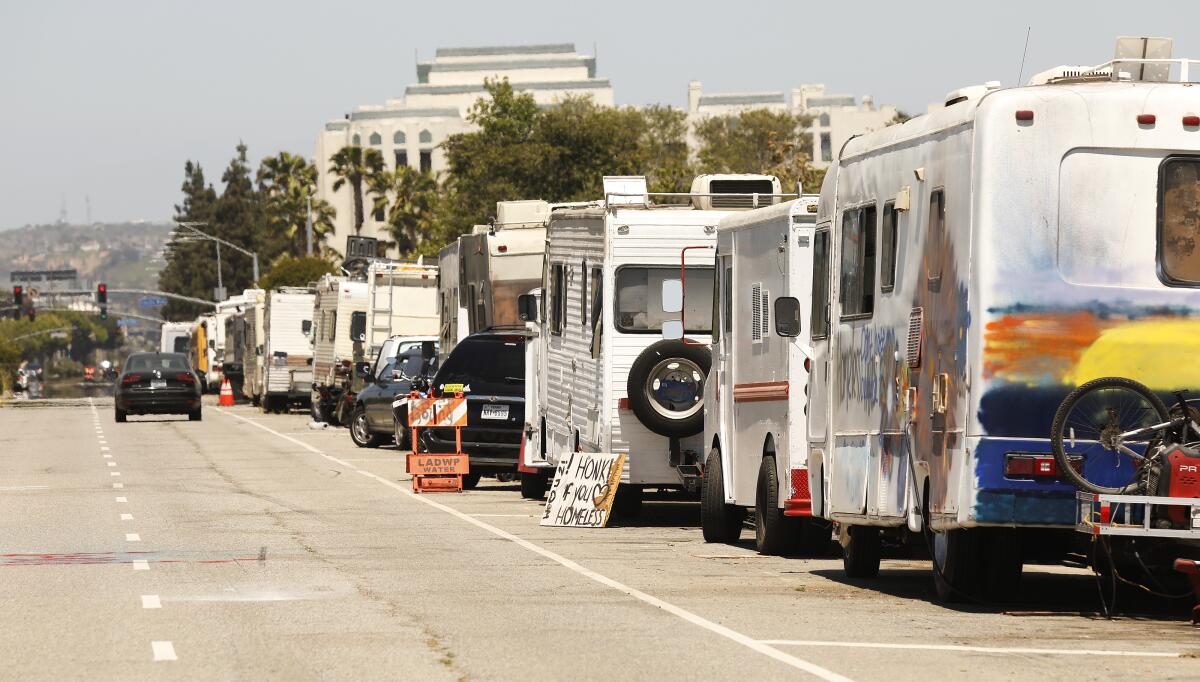
- Share via
For five nights, Melissa Grady refused to sleep.
She told me this on a recent afternoon, rubbing her eyes with blackened hands, while trying to ignore the burned husk of twisted metal that barely resembled the RV she had been sharing with her boyfriend, Woody Akiedis.
No one knows for sure how it started, but over Presidents Day weekend, a fire engulfed their metal home, melting its tires to the pavement and sending a plume of dark smoke billowing over the Ballona Wetlands, Playa Vista and Playa del Rey.
Grady, who had been asleep, saw the flames and dashed outside in panic. Akiedis did too. But then, for some reason, he went back in. Grady tried to chase him down, getting close enough to spot his ankle. But the heat was too much. Others who had run over from their own RVs couldn’t get to him either.
Eventually, firefighters found the body of Akiedis, charred and lifeless next to his prized, if now destroyed, collection of Hot Wheels toy cars. His friends said he was 60.
“I just had cinnamon rolls with him,” Grady told me in disbelief, taking a break from digging through the wreckage as a line of storm clouds moved in. “Cuddled in bed with him.”
A growing encampment has left significant damage in the freshwater marsh. But that’s no reason not to be sensitive to the needs of homeless people.
What happened to Akiedis is just one of many truly terrible incidents to befall this encampment on Jefferson Boulevard. It’s not far from my apartment, and since the start of the pandemic, I’ve watched the number of RVs — and the number of desperate people living in them — grow and shrink, and grow and shrink again.
There have been fires and overdoses, and at least one deadly shooting.
Meanwhile, the Ballona Wetlands and adjacent Freshwater Marsh, once prized destinations for bird watching, have taken a beating environmentally, with mature trees cut down, storm drains used as trash receptacles and the entire area doubling as a toilet.
“It’s so messy and so bad now,” lamented Scott Culbertson, executive director of Friends of the Ballona Wetlands.
That this encampment remains while so many tents have vanished from the Westside of Los Angeles under Mayor Karen Bass’ new “Inside Safe” initiative has caused confusion and consternation among my housed neighbors and environmentalists alike.
But there are reasons for the difference, so I’ve come to understand. Complicated reasons that more Angelenos should understand too, because what’s happening on Jefferson Boulevard is all but certain to be repeated in other parts of Los Angeles, as the city scales up its efforts to get unhoused people indoors.
“We have not resolved the RV issue yet,” Bass acknowledged. “But we absolutely will because it’s a very serious issue.”
Just don’t expect it to happen quickly. Nearly a year after the L.A. City Council voted to lift a pandemic-era moratorium on towing oversize vehicles used as homes that had been parked for months on city streets, there are all sorts of logistical problems.
Then as now, there aren’t enough trucks capable of removing such large vehicles, not enough space to store them, and not enough money to pay for it all. More recently, finding the owners of RVs has become a challenge because, quite often, the occupants are merely renters, making towing a legally dubious decision.
But those problems pale in comparison to changing the mindset of many of the people who live in those RVs.
“They don’t necessarily consider themselves as homeless,” said Va Lecia Adams Kellum, the incoming chief executive of the Los Angeles Homeless Services Authority. “This thing they had that kept them from being in a tent was extremely important to how they defined [and] how they saw themselves.”
After the storms that rolled through L.A. in January, for example, outreach workers in Venice were able to motivate people in tents to trade in their soaked bedding for a hotel room and the promise of future permanent housing.
That probably won’t work as well for those living in RVs on Jefferson Boulevard. They rolled through February’s storms with roofs over their heads and dry, if dilapidated, places to sleep.
“How,” Adams Kellum continued, “do you convince someone that they’re vulnerable and homeless, and they don’t see themselves as homeless?”
::

When I first met Wendy Lockett, she was the newest resident of the encampment on Jefferson Boulevard.
It was deep in the pandemic in the summer of 2021. I had been trudging along a trail with Culbertson, who seemed as pained about the environmental damage to the Freshwater Marsh as the humanitarian crisis playing out alongside it, when we came upon a hand-painted sign.
“DO NOT THROW TRASH OVER THIS FENCE!! IF I CATCH YOU, I WILL HUNT YOU DOWN AND EAT YOU FOR BREAKFAST.”
Lockett, a slight woman with dark hair and piercing eyes, emerged from a white van, smiling proudly at her handiwork. She told us she had been living there for about six months.
Nearly two years later, and she’s still out there. Well, I should say she’s back out there. For a time, she had moved into a hotel room near LAX, but told me she got “kicked out” for painting on the walls, mural-style. So, she got another RV and returned to the life and the people she knew.
Now with Akiedis gone, Lockett has been at the encampment the longest and, as such, feels responsible for protecting Grady, even finding her another RV.
“I’m kind of like the sheriff,” Lockett told me. “He was the mayor, for lack of better terminology. He was very diplomatic, and knew how to handle stuff. I literally go after people with bats when I lose my temper.”
As if on cue, she spotted a man stealing something from a pile of belongings outside a neighbor’s RV and took off after him yelling, her pit bull not far behind.
“There she goes,” Grady said, laughing as another woman handed her a peanut butter and jelly sandwich.
Like it or not, this RV encampment, like so many others across Los Angeles, has evolved over the last three years into what can only be called a community. An entrenched one, at that.
Those who live on Jefferson Boulevard see themselves as residents, the block along the Freshwater Marsh as their neighborhood, and their RVs spread throughout it like houses with addresses and yards. They look out for one another too.
After the firefighters had put out the flames and removed Akiedis’ remains, nosy housed residents from nearby neighborhoods started coming by. One man brought a camera and began taking photos. Lockett and other residents from the encampment pulled him aside and told him to leave, to be respectful of what had been Grady’s home.
“I was pretty disgusted by the behavior,” Culbertson recounted. “Nobody’s fought harder to get these RVs out of here than me, but for crying out loud, somebody just died.”
::
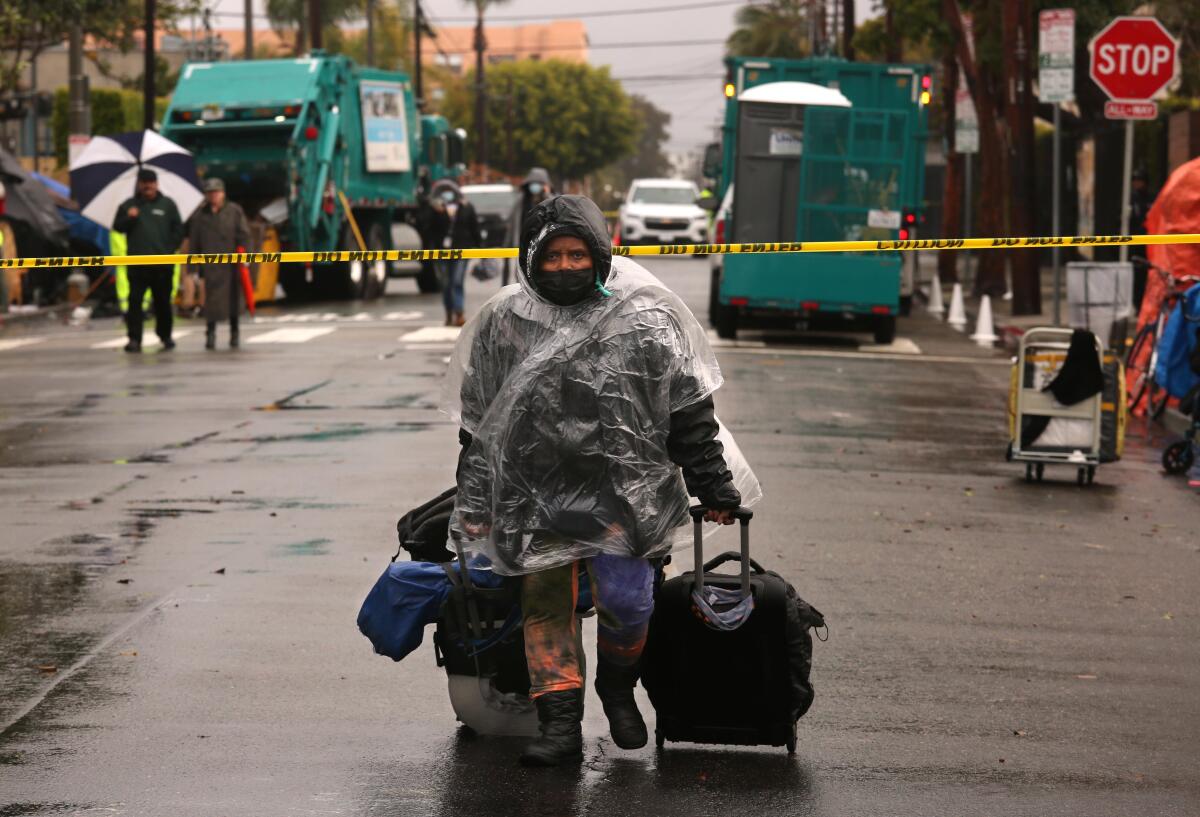
So how do you convince someone that they’re vulnerable and homeless when they don’t see themselves as homeless?
Adams Kellum has ideas.
One is to work with other organizations to secure cheap or free places to park RVs for people who have agreed to move indoors. It’s hard to believe, but apparently there aren’t enough underused, city-owned parking lots for this.
Bass found that out while exploring whether to make the encampment on Jefferson Boulevard one of the first sites to try “Inside Safe.”
“We thought we had identified a property near the airport. But it turned out that the rent for that parking lot was going to be in the millions,” she told me. “And then we had to decide, do we spend money that way? Or do we take the millions leasing motel rooms and getting people out of tents?”
Her administration chose the latter.
Another idea, which Bass favors, is to persuade people to give up their RVs for demolition. That could happen by offering to pay a lump sum for the vehicles or by wiping out parking tickets and warrants. L.A. City Councilmember Monica Rodriguez had some success with such incentives during a pilot program last year in her San Fernando Valley district.
But to do this, city officials must first convince people like Lockett that it’s worth the risk. That giving up the only shelter they have in hopes of securing something better won’t backfire. After years of bureaucratic failures and broken promises for permanent and even temporary housing, such trust is a tough sell.
“If people feel like their income is so unstable or their housing has been unstable all these years, it’s hard for them, right? Their mindset is, ‘I’m not in the tent,’” Adams Kellum said. “‘What do I do if I fall out of housing? Like, what if I lose my voucher or I lose my job?’”
What’s clear is that offers of hotel rooms probably aren’t going to be enough for RV dwellers, who feel as though they already are in a form of temporary housing. Permanent housing will be key, but it’s in short supply.
City officials voted to lift a moratorium on towing illegally parked campers, citing complaints from residents of human waste, drug use and trash.
In the meantime, L.A. City Councilmember Traci Park, whose Westside district takes in the Ballona Wetlands and Freshwater Marsh, said city sanitation workers have visited the RV encampment on Jefferson Boulevard multiple times in the past two months, and have removed tens of thousands of pounds of trash and hazardous waste.
The number of RVs, by her office’s count, has dropped from 50 to about 25, thanks in part to efforts by outreach workers. Many more are parked across the city and unincorporated county.
“I am extremely concerned about the unsafe conditions that those RVs present for the people who are living in them,” Park said. “A lot of folks are using gas-powered generators for electricity and heat, folks are using space heaters and warmers inside those RVs, many of which cannot pass basic fire safety standards.”
I’m extremely concerned too. But watching Grady sift through lumps of burnt debris just feet from where Akiedis died, looking for anything salvageable enough to move to her new RV, it’s clear that she wasn’t.
“I thank God we had him,” Grady said, “even if it wasn’t long enough.”
- Share via
Watch L.A. Times Today at 7 p.m. on Spectrum News 1 on Channel 1 or live stream on the Spectrum News App. Palos Verdes Peninsula and Orange County viewers can watch on Cox Systems on channel 99.
More to Read
Sign up for Essential California
The most important California stories and recommendations in your inbox every morning.
You may occasionally receive promotional content from the Los Angeles Times.

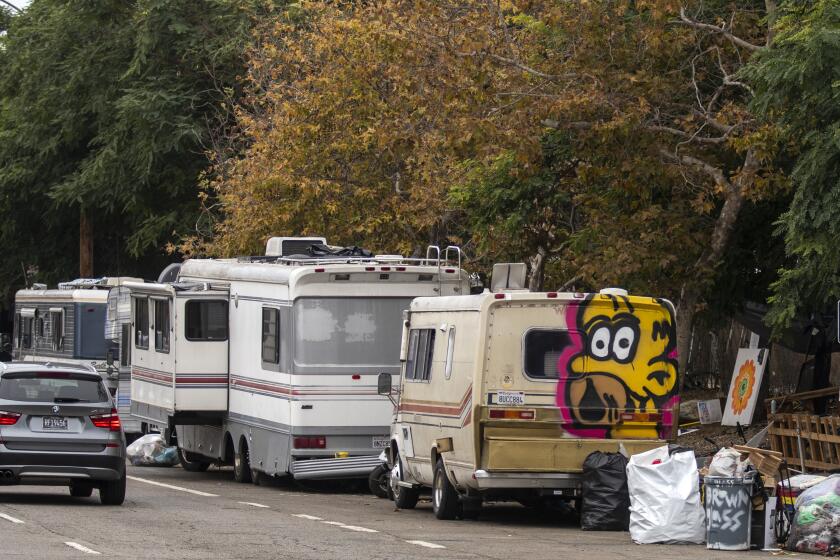
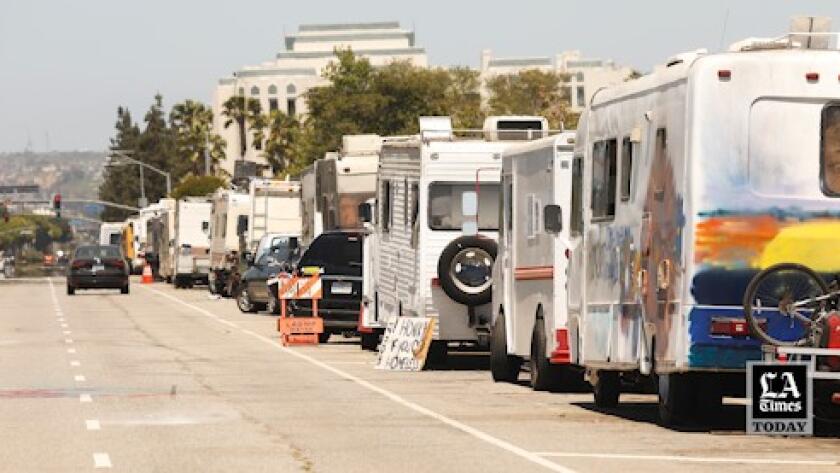
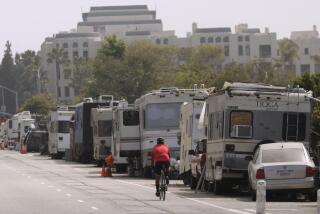

![Los Angeles, CA - May 19: Carlos Vargas, left, and Paulina Rubio, members of the harm reduction team from Homeless Outreach Program Integrated Care Systems [HOPICS], a leading homeless services and housing agency, look for drug addicts to help and pass out supplies at a homeless RV encampment along 77th St. in South Los Angeles Friday, May 19, 2023. The team hands out syringes, fentanyl test strips, overdose reversal nose spray and medication to prevent overdoses, infection and disease transmission, including the HIV virus. Fenanyl is particularly insidious because it can be found in all other drugs, especially meth and heroin. The handouts are also meant to reduce infection through broken pipes, which can cut users mouths and open them to infection. . (Allen J. Schaben / Los Angeles Times)](https://ca-times.brightspotcdn.com/dims4/default/530e2db/2147483647/strip/true/crop/3900x2608+0+34/resize/320x214!/quality/75/?url=https%3A%2F%2Fcalifornia-times-brightspot.s3.amazonaws.com%2Fe9%2F77%2F4b8bd35d4881a3edec6b945b143b%2F1298639-me-soaring-fentanyl-deaths-24-1-ajs.jpg)








